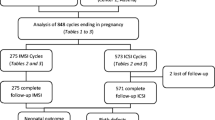Abstract
Purpose: Our purpose was to assess the incidence of multiple pregnancies and their obstetric outcome after intracytoplasmic sperm injection.
Methods: The study group comprised women who delivered twins or triplets after intracytoplasmic sperm injection and standard in vitro fertilization. The incidence and main perinatal outcome of 140 multiple pregnancies resulting from intracytoplasmic sperm injection or standard in vitro fertilization treatment were analyzed.
Results: A total of 60 multiple pregnancies was obtained after intracytoplasmic sperm injection (3.4 ± 1.1 embryos/cycle) and 80 after standard in vitro fertilization (3.3 ± 2.0 embryos/cycle). The incidence of multiple pregnancy, i.e., 22.6 compared to 20.7%, respectively, was calculated. The obstetric outcome of 47 multiple pregnancies after intracytoplasmic sperm injection was 39 twin deliveries at between 27 and 37 weeks of gestation (mean, 36 ± 3.3) and 8 successful triplet deliveries between 26 and 36 weeks of gestation (mean 32.6 ± 2.4). The outcome after regular in vitro fertilization was similar. No major malformations were observed.
Conclusions: The results of this study showed that the incidence of multiple pregnancies after intracytoplasmic sperm injection was similar to that after standard, conventional in vitro fertilization. The perinatal outcome did not differ between both groups.
Similar content being viewed by others
REFERENCES
Wisanto A, Magnus M, Bonduelle M, Liu J, Camus M, Tournaye H, Liebaers I, Van Steirteghem AC, Devroey P: Obstetric outcome of 424 pregnancies after intracytoplasmic sperm injection. Hum Reprod 1995;10:2713–2718
Roest J, van Heusden AM, Verhoeff A, Mous HVH, Zeilmaker GH: A triplet pregnancy after in vitro fertilization is a procedure-related complication that should be prevented by replacement of two embryos only. Fertil Steril 1997;67:290–295
Lipitz S, Reichman B, Uval J, Shalev J, Achiron R, Barkai G, Mashiach S: A prospective comparison of the outcome of triplet pregnancies managed expectantly or by multifetal reduction to twins. Am J Obstet Gynecol 1994;170:874–879
Seoud MA, Toner JP, Kruithoff C, Mausher SJ: Outcome of twin, triplet and quadruplet in vitro fertilization pregnancies: The Norfolk experience. Fertil Steril 1992;57:825–834
Bernasko J, Lynch L, Lapinski R, Berkowitz RL: Twin pregnancies conceived by assisted reproductive techniques: Maternal and neonatal outcomes. Obstet Gynecol 1997;89:368–372
Seoud MA, Kruithoff C, Mausher SJ: Outcome of triplet and quadruplet pregnancies resulting from in vitro fertilization. Eur J Obstet Gynecol Reprod Biol 1991;41:79–84
Kingsland CR, Steer CV, Pampiglione JS, Mason BA, Edwards RG, Campbell S: Outcome of triple pregnancies resulting from IVF at Bourn Hallam 1984–1987. Eur J Obstet Gynecol Reprod Biol 1990;34:197–203
Friedler S, Mordel N, Lipitz S, Mashiach S, Glezerman M, Laufer N: Perinatal outcome of triplet pregnancies following assisted reproduction. J Assist Reprod Genet 1994;11:459–462
Callahan TL, Hall JE, Ettner SL, Christiansen CL, Greene MF, Crowley WF: The economic impact of multiple-gestation pregnancies and the contribution of assisted-reproduction techniques to their incidence. N Engl J Med 1994;331:244–249
Staessen C, Janssenswillen C, Van Den Abbeel E, Devroey P, Van Steirteghem AC: Avoidance of triplet pregnancies by elective transfer of two good quality embryos. Hum Reprod 1993;8:1650–1653
Tasdemir M, Tasdemir I, Kodama H, Fukuda J, Tanaka T: Two instead of three embryo transfers in in-vitro fertilization. Hum Reprod 1995;10:2155–2158
Medical Research International, Society for Assisted Reproductive Technology (SART), The American Fertility Society: In vitro fertilization-embryo transfer (IVF-ET) in the United States: 1990 results from the IVF-ET Registry. Fertil Steril 1992;57:15–24
Society for Assisted Reproductive Technology, American Society for Reproductive Medicine: Assisted reproductive technology in the United States and Canada: 1993 results generated from the American Society for Reproductive Medicine/Society for Assisted Reproductive Technology Registry. Fertil Steril 1995;64:13–21
Dor J, Ben-Shlomo I, Levran D, Rudak E, Yunish M, Mashiach S: The relative success of gonadotropin-releasing hormone analogue, clomiphene citrate, and gonadotropin in 1,099 cycles of in vitro fertilization. Fertil Steril 1992;58:986–990
Van Steirteghem AC, Liu J, Joris H, Nagy Z, Janssenswillem C, Tournaye H, Derde MP, Van Assche E, Devroey P: Higher success rates by intracytoplasmic sperm injection than by subzonal insemination. Report of a second series of 300 consecutive treatment cycles. Hum Reprod 1993;8:1055–1060
Madgar I, Seidman DS, Levran D, Yonish M, Augarten A, Yemini Z, Dor J: Micromanipulation improves in-vitro fertilization results after epididymal or testicular sperm aspiration in patients with congenital absence of the vas deferens. Hum Reprod 1996;11:2151–2154
MacLennan AH, Green RC, O'Shea R, Brookes C, Morris D: Routine hospital admission in twin pregnancy between 26–30 weeks gestation. Lancet 1990;335:267–269
Knuppel RA, Lake MF, Watson DC, Welch RA, Hill WC, Fleming AD, Martin RW, Bentley DL, Moenning RK, Morrison JC: Preventing preterm birth in twin gestation: home uterine activity monitoring and perinatal nursing support. Obstet Gynecol 1990;76:24S–27S
Thompson SA, Lyons TL, Makowski EL: Outcome of twin gestation at the University of Colorado Health Sciences Center, 1973–1983. J Reprod Med 1987;32:328–339
Spellacy WN, Handler H, Ferre CD: Case-control study of 1253 twin pregnancies from 1982–1987 perinatal data base. Obstet Gynecol 1990;75:168–171
Sassoon DA, Castro LC, Davis JL, Hobel CJ: Perinatal outcome in triplet vs twin gestations. Obstet Gynecol 1990;75:817–820
Lipitz S, Reichmann B, Paret G, Modan M, Shalev J, Serr DM, Mashiach S: The improving outcome of triplet pregnancies. Am J Obstet Gynecol 1989;161:1279–1284
Author information
Authors and Affiliations
Rights and permissions
About this article
Cite this article
Bider, D., Livshitz, A., Tur Kaspa, I. et al. Incidence and Perinatal Outcome of Multiple Pregnancies After Intracytoplasmic Sperm Injection Compared to Standard In Vitro Fertilization. J Assist Reprod Genet 16, 221–226 (1999). https://doi.org/10.1023/A:1020351026364
Issue Date:
DOI: https://doi.org/10.1023/A:1020351026364




